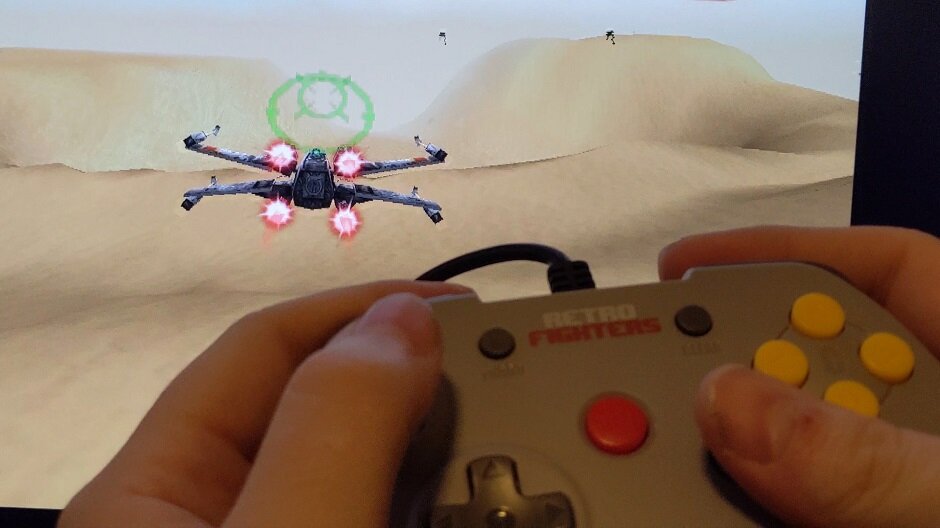The Wireless Legacy 16 has cemented itself as an essential controller for my Super Nintendo needs. But it isn’t the only SNES-inspired controller Retro-Bit has released. Alongside the Wireless Legacy 16, came a Wired Legacy 16 designed for use with USB devices. This wired variant, while lacking in some areas compared to its counterpart, has proven to be an interesting input device, but one whose application is going to be very niche.
What’s In The Box
Review sample provided by Retro-Bit
The Wired Legacy 16 comes in a compact box with the controller taking center stage in a near life-size depiction. System compatibility is also notated. Along the side of the box are a few highlights of the Wired Legacy 16’s design. The back of the box further highlights these features with some nice product shots to accompany them. Inside the box is the Legacy 16, thank you note complete with social media handles for Retro-Bit, and a user’s manual containing default button layouts and macros.
Aesthetics And Build Quality
Like the Wireless version, the Wired Legacy 16 comes in 2 color options: Onyx and Classic Grey. The size matches that of the Wireless Legacy 16 and nearly that of an official SNES pad. The black and grey color scheme has a nice contrast and the colored face button labels are very pleasing to me. I am also happy that the concave and convex buttons found on North American SNES pads are featured on the Wired Legacy 16. The biggest design differences between the wired and wireless variants of the Legacy 16 are the removal of the 2 analog thumbsticks and the positions of the shoulder buttons. Otherwise, the controllers are a near-exact match for feel.
Face buttons feel great to the touch while the D-pad comes in a bit too close to the stiff side, but more on that in a bit. The shoulder buttons have a completely different feel to them compared to the Wireless Legacy 16 and I have been absolutely loving them. The bigger, primary shoulder buttons have a traditional membrane while the smaller ones have a microswitch, giving them their own unique feel when pressed. The cord comes in at 10-feet which should allow for more than enough length in most setups and it is attached firmly to the controller. The Wired Legacy 16 feels solid in the hands and can withstand a good amount of punishment.
Gameplay
Because of its USB-only operation and lack of thumbsticks, the Wired Legacy 16 is going to have far fewer use cases compared to its Wireless counterpart. That isn’t necessarily a bad thing, mind you, but one to take into consideration, as the Wired Legacy 16 is going to be very niche in the modern gaming scene. For myself, that use has come from the Nintendo Switch Online’s library of SNES games. You have access to every button needed to fully utilize every extra feature, and the layout being identical to an official SNES pad is fantastic. I have had an enjoyable time with the Wired Legacy 16 for this purpose and it works extremely well for it. This of course also translates well over to the NES library of games.
But there are a number of other Switch titles that can benefit greatly from a retro-themed controller like this, such as the various retro compilations that have graced the system since its launch! Playing through the Mega Man X Legacy Collection feels right at home on the Wired Legacy 16, and playing the PS1 era games in particular with a SNES-style pad gives me far more joy than it should. The same thing happens for me when revisiting the SNES version of The Lion King. The Wired Legacy 16 can handle all of those fun jumping sections with ease.
The Street Fighter 30th Anniversary Collection is another title I personally feel benefits from this style of controller if you aren’t going full-on Fight stick. Again the D-pad is a bit on the stiffer side, similar to that found on the classic GBA, but it feels really good in use. The D-pad registers each direction well, and even though I’m never going to be an FGC champ, I can at least pull off all the moves I am intending when I intend to. I grew up with the SNES so I actually prefer the 4 face button 2 shoulder button layout for fighting games.
Jumping into an assortment of indie games or single-stick and D-pad only games should also work well. Thanks to the included macros on the controller you can change the Legacy 16’s D-pad between various modes of operation, including left and right analog modes and a D-pad mode. By default, the controller is set to the left analog stick mode which allows it to instantly work in games like Link’s Awakening! Other macros also allow you to change the layout of the face and shoulder buttons to help you fine-tune your gaming experience. There is no support for the Switch’s built-in pro controller remapping features on the Wired Legacy 16.
These same use cases will also apply to using the Legacy 16 on a PC, but you also gain the advantage of using the controller on an expanded library of SNES games through emulation! Thanks to the controller supporting both Direct Input and X-input, there is compatibility with a number of legacy operating systems as well, and this style of controller is well suited for games of that era!
What It Could Have Done Better
While the Wired Legacy 16 works well for what it does, it is a device that will have limited use. The lack of analog sticks keeps it from being a classically designed all-in-one device and the lack of SNES-input support seems to deny it its original purpose. The lack of motion controls and rumble is also worth noting, but for what this controller’s intended purpose is, it is less of an issue compared to its wireless counterpart.
Verdict
The Wired Legacy 16 is a beautiful and well-built input device, but one that is going to be very niche. It handles the games it is capable of extremely well and is sure to delight those of you out there looking for this type of input device. But due to the lack of SNES support, I don’t know how often I will find myself personally using it compared to its wireless counterpart that can do all of the same things, plus support original hardware and dual analog play. If you have a need for a classic-inspired controller like this though, it won’t let you down!

























